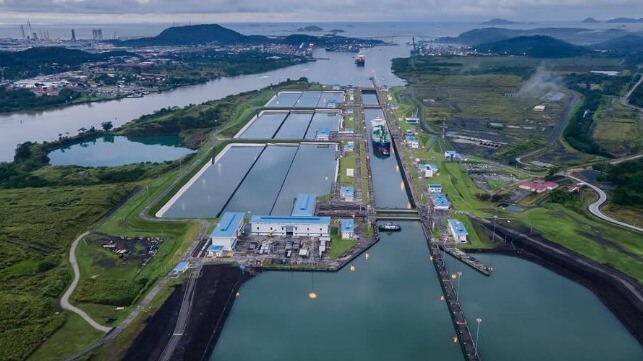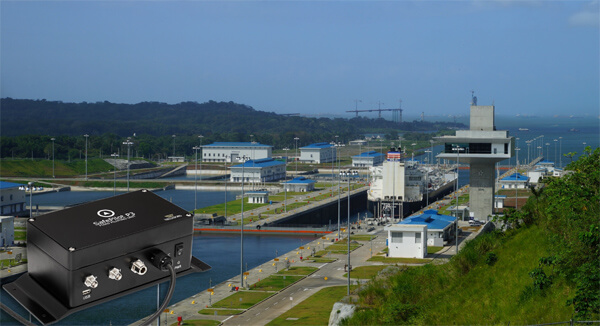Trelleborg's SafePilot P3: A Proven Solution for Panama Canal Transits

In a recent advisory, the Panama Canal Authority (ACP) announced new positioning requirements for transiting Neopanamax vessels. This includes requiring all Neopanamax ships to carry a fixed installed piloting unit from October 2023.
With the objective of enhancing the safety and efficiency of transiting vessels, the ACP’s incoming criteria will eradicate the use of portable piloting units. Vessel operators that do not carry a fixed installed piloting unit from that date will face incurring potential delays and additional costs.
Key aspects of the Panama Canal’s requirements for Neopanamax vessels include:
• Effective October 1, 2023, vessels with a beam of 109 feet or more transiting the Panama Canal must have a fixed (non-portable) piloting unit with Real Time Kinematics (RTK) for submeter accuracy.
• This requirement aims to eliminate delays associated with the installation of portable piloting units (PPU-RTK) and improve the waterway's efficiency.
• Vessel operators are responsible for procuring, installing, configuring, and maintaining the fixed piloting unit in proper condition.
• Compliance with the piloting unit requirement will be part of the vessel's arrival inspection.
• If the vessel does not meet the requirement, a portable piloting unit with RTK (PPU-RTK) will be temporarily installed at an additional cost.
• Non-compliance may lead to transit delays, additional costs, and possible fines.
For nearly a decade, the ACP has depended on Trelleborg’s SafePilot system for all piloting in the Panama Canal. Based on this strong track record, Trelleborg Marine & Infrastructure developed the SafePilot P3 Navigation System as a direct response to providing full compliance with these requirements.
Since its initial rollout in October 2022, the SafePilot P3 system has garnered significant traction, with successful deliveries and installations on numerous vessels worldwide.
Tommy Guldhammer Mikkelsen, Managing Director for Navigation and Piloting operations at Trelleborg Marine and Infrastructure, explained the development of SafePilot P3, its guaranteed compatibility with the ACP’s requirements and how the system will improve the safety and efficiency of vessel transits on tight waterways:
Q: Can you tell us about the history and development of the SafePilot P3 Navigation System?
A: Certainly. The development of the SafePilot P3 unit stemmed from the need to address the evolving requirements of transiting Neopanamax vessels in the Panama Canal. We realized that existing technologies and lengthy pilotage processes needed a significant upgrade to ensure safer and more expeditious transits. Tapping into our unique understanding of the ACP’s requirements, we embarked on revamping the technology and enhancing the fixed piloting unit concept. For the past eight years, the ACP has been using SafePilot for all piloting at the Panama Canal, which has provided us with valuable insights and feedback.
Q: Can you share some insights into the system's adoption and success in the market?
A: SafePilot P3 has already gained significant traction in the market and has been sold to a large number of vessel owners and operators. Its successful adoption by various vessels highlights the confidence and trust placed in the system. Thanks to the combined contribution of Maersk and the ACP, we achieved the first successful transit using the SafePilot P3 system and showcased the system's capabilities reinforcing its position as a reliable solution.

Q: How does the SafePilot P3 Navigation System ensure compatibility with the ACP's SafePilot system?
A: SafePilot P3 guarantees compatibility with the ACP's SafePilot system by ensuring seamless integration and operation. This is a critical advantage over other solutions, as compatibility issues can cause delays and disruptions during transits. Vessels equipped with SafePilot P3 can rely on a smooth transition into the ACP's piloting system, minimizing any potential technical hurdles.
Q: What are the key benefits of the SafePilot P3 Navigation System?
A: The SafePilot P3 offers several key features and benefits. Firstly, it provides highly accurate, real-time data that improves safety during pilotage. The system enhances situational awareness for captains and pilots during canal transits and port approaches. Intelligent filtering ensures that users only receive relevant data, enabling more effective decision-making. Additionally, the system improves communication between the captain, pilot, tug, and canal personnel, reducing incidents and downtime through automated data capture and exchange. Lastly, the SafePilot P3 allows for safer navigation in a wider range of meteorological conditions.
Q: What unique features does the SafePilot P3 Navigation System offer to vessel operators? How does it differ from other existing systems?
A: SafePilot P3 includes a portable precision navigation display on an iPad - SafeCaptain, providing vessel operators with a convenient tool for monitoring and verifying the system's accuracy. This validation feature allows operators to check the system's functionality before initiating communication with the Panama Canal. Furthermore, the system incorporates a spoofing and jamming alert, offering an added layer of protection against potential cyber threats.
SafePilot P3 differs from other existing systems since it offers superior performance and accuracy. It delivers highly precise, real-time data that is essential for safe pilotage. The system also includes advanced motion sensors and a high-accuracy global navigation satellite system (GNSS) that measures the vessel's movement in three dimensions, computing position and heading based on dual GNSS antennas. Additionally, it incorporates a built-in backup battery, independent heading capability, and advanced spoofing and jamming detection.
A digital certificate is a crucial part of this new system that sets it apart from the standard AIS Pilot plug on board vessels today.
Q: Could you elaborate on the digital certificate requirement and its significance?
A: Upon the vessel's initial arrival at the Panama Canal with a fixed piloting system on board, the ACP will provide a digital certificate, encompassing various data including antenna offsets. This process guarantees that during subsequent visits, there remains an assurance of full compliance and system integrity without any tampering.
Q: How user-friendly is the SafePilot P3 Navigation System for vessel operators?
A: SafePilot P3 was specifically designed to be a plug-and-play solution, making it user-friendly and easy to install and operate. Every time a vessel calls at the Panama Canal, operators have the availability to validate that the system is fully functioning, providing peace of mind and confidence in the system's reliability.
Q: How does the SafePilot P3 Navigation System integrate with other technologies?
A: The SafePilot P3 works seamlessly with the SafeCaptain App, which serves as a portable display for captains. The app displays official sea charts with overlays designed for precise vessel navigation. This integration provides comprehensive data and enhances situational awareness for users. The SafePilot P3 can be used globally on all ports and waterways, making it a versatile solution.
To summarize, SafePilot P3 is a tried and tested, fully compliant and compatible system with the new ACP regulations, allowing for seamless integration during transits. By providing highly accurate real-time data, improved situational awareness, and effective communication, it enhances safety and efficiency whilst reducing incidents and downtime.
Additionally, it offers a portable navigation display on an iPad, spoofing and jamming alerts for cyber protection.
With its user-friendly design and plug-and-play installation, SafePilot P3 represents a significant milestone in safety and efficiency of Neopanamax vessel transiting through the Panama Canal, providing vessel operators with the confidence to navigate one of the world’s most critical waterways as seamlessly as possible. Safe Pilot 3 is another demonstrable example of Trelleborg’s ongoing commitment to adapting to and meeting the evolving needs of the maritime industry.
This article is sponsored by Trelleborg. For more information on Safe Pilot 3 visit: https://safepilotp3.com/

that matters most
Get the latest maritime news delivered to your inbox daily.
The opinions expressed herein are the author's and not necessarily those of The Maritime Executive.
